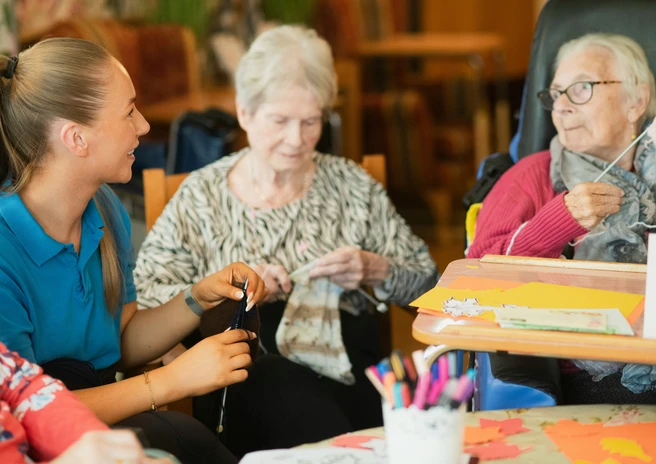A new study by the Associate Professorship of Didactics in Sport and Health shows: Care workers in long-term care experience different types of strain depending on whether they work in residential or home-based care. These differences have a direct impact on burnout risks and work ability. The study “Demands, resources, burnout, and work ability in long-term care: A multi-group structural equation model comparing residential and home care” was published in the International Journal of Nursing Studies, which has an impact factor of 7.1.
“In this publication, it was important for us to bring together the individual findings from our various studies in the field of care and thus contribute to new insights. I am very pleased that this integrative approach was published in such a highly renowned journal. This shows not only that the topic is socially relevant, but also that the methodological approach is innovative,” explains Prof. Dr. Filip Mess, head of the Associate Professorship of Didactics in Sport and Health.
Different demands, different impacts
Care workers make a crucial contribution to healthcare, but they themselves are exposed to very high physical and psychological stress. In Germany, the care profession is considered particularly demanding, as evidenced by an above-average number of sick days and high job turnover.
The newly published paper is based on data from the projects “EMMA” and “CaResource.” Using the Job Demands-Resources model (JD-R model), Dr. Doris Gebhard, Michael Herz, and Dr. Simon Blaschke – all Research Associates at the Associate Professorship of Didactics in Sport and Health – examined the relationships between job-related demands (“demands”), resources (“resources”), burnout dimensions, and work ability. A total of 301 care workers from residential and home-based long-term care were surveyed. The goal was to determine whether and how these relationships differ between the two care settings.
Demands lead to exhaustion – resources have a protective effect
The results show a clear pattern: high demands – such as emotional requirements, role conflicts, or challenges in balancing work and private life – are closely linked to emotional exhaustion, one of the central dimensions of burnout. At the same time, personal and organizational resources, such as meaningfulness of work or resilience, have a positive effect on mental health.
“In both professional groups, we observed that demands increase emotional exhaustion. Resources, on the other hand, strengthen the sense of personal efficacy and therefore protect against burnout,” explains Michael Herz. One particularly striking finding: the relationship between exhaustion and work ability differed significantly between the settings. In home care, emotional exhaustion was strongly negatively linked to work ability, whereas in residential care it was not.
The differences between residential and home-based care can be explained mainly by the occupational contexts. While care workers in home care often work alone and face challenging situations in people’s homes every day, employees in residential facilities work more within teams and in clearly structured environments. “These framework conditions influence how strain is experienced and managed. Care workers therefore need setting-specific support,” notes Dr. Gebhard.
A central conclusion of the study: there are no one-size-fits-all solutions! Accordingly, initial measures have already been developed – for example, improving communication structures in home-based care or strengthening teamwork in residential facilities through cooperative exercises and appreciation formats.
Self-care as a key resource
Another important aspect is raising awareness of one’s own health. “Care workers spend all day taking care of others – but rarely of themselves,” says Dr. Gebhard. Measures for self-care, such as short breaks, mindfulness exercises, or small recovery rituals, were therefore integrated as central intervention components in both settings.
“If we want to retain care workers in their profession in the long term, we must actively promote their health – precisely where they work,” concludes the research team. “Residential and home care differ significantly – and this should be reflected in our health programs,” adds Herz.
To the homepage of the Associate Professorship of Didactics in Sport and Health
To the study: “Demands, resources, burnout, and work ability in long-term care: A multi-group structural equation model comparing residential and home care”
Contact:
Prof. Dr. Filip Mess
Associate Professorship of Didactics in Sport and Health
Am Olympiacampus 11
80809 Munich
phone: 089 289 24520
e-mail: filip.mess(at)tum.de
Dr. Doris Gebhard
Associate Professorship of Didactics in Sport and Health
Am Olympiacampus 11
80809 Munich
phone: 089 289 24972
e-mail: doris.gebhard(at)tum.de
Dr. Simon Blaschke
Associate Professorship of Didactics in Sport and Health
Am Olympiacampus 11
80809 Munich
phone: 089 289 24529
e-mail: simon.blaschke(at)tum.de
Michael Herz
Associate Professorship of Didactics in Sport and Health
Am Olympiacampus 11
80809 Munich
phone: 089 289 24526
e-mail: mi.herz(at)tum.de
Text: Bastian Daneyko
Photos: Photo by Age Cymru on Unsplash/private




